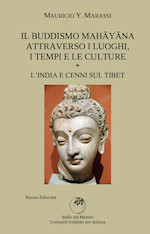This dynamic relation between life and zazen is not underlined only in the ancient sutras, like the Dhammapada. It is also explained in much detail in the already mentioned Dasheng Qixinlun (32), a treatise produced in the VI century a.D. by an author whom all scholars now believe to be Chinese.
To avoid all misunderstandings, let me make clear that my words are not critical of Dōgen’s zen, but of the attempt to export the form in which Buddhism was shaped in one cultural area as if this form were the Universal. Dōgen knew that the Confucian ethics was not up to the task of placing and keeping us tuned in to the divine in our soul, because that ethics pertains to the field of human relations, and to the social behaviour: “soto shitagau” (外従う) means “outside, in the sphere of the world, give into” (33).
Dōgen’s authentic thought is clearly expressed in works like Shōbōgenzō Bodaisatta Shishobō (34) or the Tenzo Kyōkun, Instructions for the zen cook (35) which recommends that three forms (36) of love should mould all our existence, both when conditions are such that one should obey others as when it is instead necessary to rise up against them or even to exercise command over them.
I would also be misunderstood if I was believed to be saying that, since Buddhism is an Indian matter, only Indian cultural categories can contain it. It is not so. From the very start Buddhism presents itself as paţisotagāmin (37) “[that who] swims against the tide, goes upstream” and this is true both in the deeper sense of “giving up the aimless wandering (samsāra)”, in the sense of “keeping apart from the flow of thoughts and desires”, and in a the more self-evident sense of “being always a foreigner, an alien to every way of thinking” (38). Buddhism does not belong therefore to any culture in particular. Even in India it had to become enculturated, and it took more than three centuries. Almost as much as it took in China.
V) Zazen is not enough for zazen
As we already said, Universality does not exist in the naked, if it wants to become visible, it has no choice but to cloth itself with what is supplied by the culture within which it is (re)born at that time. The thing is that, dressed up that way in that instant may be particular, but is truly universal. However, if we act on the presupposition that the specific form in which the infinite reveals itself in that moment is authentic and good, and try to transplant it, to give it life in another environment, where culture and sensitivities are different, that which was authentic Zen at home, it no longer is: it is an ethnic play-acting empty of any religiosity and universality.
I am not thinking only of the tea ceremonies portrayed as if they were “zen rituals”, of the oriental-looking decor of meditation halls, the somewhat silly, incessant repetition of Japanese or Chinese terms in Western contexts that clash head on with these mannerisms. I am referring to more significant forms of this incongruence. Western culture has made individualism, the pursuit of uniqueness and originality the yardstick of man and the standard value of its existence. To portray meek obedience and conformity as the perfect and doctrinally appropriate embodiment of the emptiness preached by the Middleway is the opposite of an attempt of enculturation. If we do this, we are advocating neither for Buddhism nor for universality but for a cultural project, that is foreign to the context in which we propose to nurture it. Over the long run, the enthusiasm for things foreign is certain to be replaced by rejection and boredom.
Universal is in the effort to redefine what is universal over and over again. Universal is the capacity for universality that is born again and again in every person that begins to live it, or, more generally, in every generation that (re)discovers it, interpreting it anew in the light of his culture. The opposite of “universality” are imitation and the adoption of conventional and orthodox views. We can talk of universality in Buddhism only when every man, every generation and every culture can develop his own Buddhism, and, at the same time, no Buddhism excludes the other, when every mountain is visible by all others.
Side by side to very strong expressions, like “zazen shitara oshimai!” (39), it is opportune to place emphasis with equal strength on the two other elements of man’s endeavour to sink into the universal. The awakening to the emptiness of the self is the state of impermanence in which the world fading away to the world in the world becomes one with nirvāņa. The other is a spiritual ethics that consists in constructing a vibrant reality of the same substance as that of the world while the world fades away: “Make haste in doing good; check your mind from evil; for the mind of him who is slow in doing good delights in evil” (40).
Without awakening to the fading world and spiritual ethics, even if “the correctly transmitted dharma from Buddha to Buddha and from patriarch to patriarch has always been just to do zazen” (41) and “zazen itself is the posture of awakening” (42), zazen may end becoming a technique for psycho-physical relaxation or a tool of those who want to become “someone” or something “special”.
Notes:
32) Treatise on the Awakening of Faith in the Mahāyāna. In Hakeda’s already mentioned translation: cf. 56 ss. and 81 ss.
33) In this case, I do not believe that Dōgen meant “adapt to the circumstances, obey when it is appropriate that you should, rebel and do it your way when it is necessary”. His own explanation of this statement is very clear in this regard: “Gesō wa tani shitagai (外相は 他に従い)” which means: “Getting along with others outside” (Shōbōgenzō Zuimonki 2-10).
34) For Dimensions of a Living Bodhisattva Spirit.
35) Cf. E.Dōgen-K.Uchiyama, Refining your life, Weatherhill, New York-Tokyo 1983, translation by Daitsu Thomas Wright.
36) “Rōshin” 老心, “kishin” 喜心, “daishin” 大心, or: “fatherly (motherly) heart”, “joyful heart”, “noble heart”.
37) Cf. Khuddakanikāya, 4: Itivuttaka IV. 10 (109) where paţisotagāmin is employed as a synonym for nekkamma/naișkramya or “letting go” which constitutes the intimacy of staying seated. See also: J.Hubbard & P.L.Swanson, Pruning the Bodhi Tree, University of Hawai’i Press, Honolulu 1997, 94.
38) The statement “anātman”, very shocking in that contest, is the clearest sign of this going against the stream.
39) “To sit zazen: end-all”. Cf. n.20.
40) Dhammapada, 116. http://www.serve.com/cmtan/Dhammapada/evil.html.
41) Eihei Kōroku, section IV.
42) Eihei Kōroku, section IV.
(Translated into English by Mr. Carlo Geneletti)
2 Responses to “The Universality of Buddhism (part five)”
Se volete, lasciate un commento.
You must be logged in to post a comment.








Febbraio 5th, 2008 at 10:47 am
I appreciate this article very much and I find it a very concerning matter.
I was not so interested in going to La Gendronniere ( I am ordained in the Deshimaru lineage) at some of this “historical” events because of thoughts like these, if I may dare to say so. However, my thoughts were more vague and
not as clear as your article. Indeed a good work. The mentioning of the Harappa civilisation
is indeed a deep trace in the sands of time.
but alas, the future…I think/feel that you may be very right on this issue. But do not know what would be the alternative. If we want to practice we need to have a sangha; as it is, in general in the group-situation we can push ourselves further beyond ourselves than we can go by ourselves. And in organizing the group…The japanese really know how to do that, no?
If I understand you correctly you are asking for another way of decision-making and as Europeans we have another way of doing that.
I have been at Antaiji and liked it very much.
It felt fresh. I was impressed by the way things were run. The “clique-atmoshere”, I have experienced in many other zen-temples/dojos did not exist and I felt that the practice probably terminates many , if not all attempts and ambitions to be “special”, (at least when you are there).
And if this “specialness” dont exist, there is more possibilities for communication between different kinds of people, and that may be the exact way to proceed.
Thank you very much
Febbraio 6th, 2008 at 11:31 am
Dear Fredriksson (is it right?),
Thank you for your kind comment.
The first blade of grass in a bare field grows alone. If it is healthy, sooner or later around him has brothers. If, as it is alone, we build around him a structure similar to grass tufts of its species, its true brothers may not be born, will be blocked. Perhaps for a while we must grow alone, doing mistakes, correcting them and doing again (new and same) mistakes. Just like a blade of grass someone will disappear, others will succeed and there will be a true reality. If we use an imitation of Japanese world to build an artificial reality, it will be dead from the beginning. So I think, but it’s not easy for anyone.
Take care of you
yushin